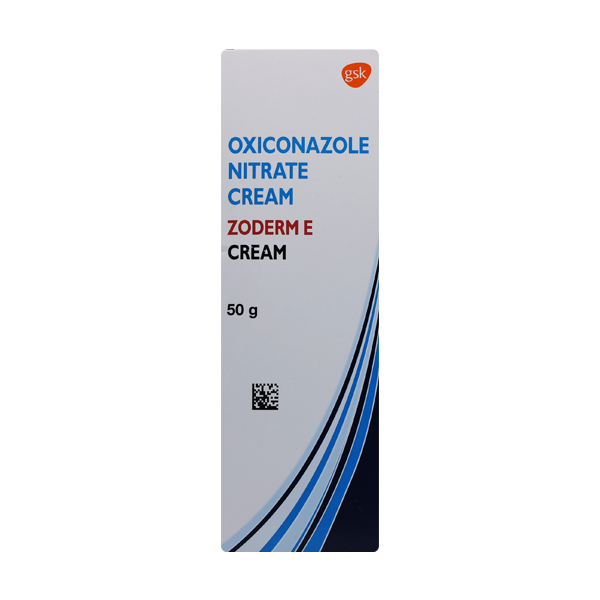Description
About Zoderm E Cream
Zoderm E Cream is used to treat fungal infections of the skin like dry and flaky skin, thrush, dhobie itch, ringworm, jock itch and athlete’s foot. Fungal infection is a skin disease in which a fungus attacks the tissue and causes infection. Fungal infections may be contagious (spread from one person to another).
Zoderm E Cream contains Oxiconazole, which is used to treat fungal skin infections. It works by causing holes in the fungal cell membranes and kills fungi. Fungal cell membranes are essential for fungus survival as they prevent the entry of unwanted substances into the cells and stop the leakage of cell contents. Thereby, it clears the fungal infection.
Take Zoderm E Cream as prescribed by your doctor. Depending upon your medical condition, you are advised to take Zoderm E Cream for as long as your doctor has prescribed it for you. In some cases, you may experience certain common side effects, such as dry skin, skin irritation, burning sensation, blisters on the skin, and skin peeling. Most of these side effects of Zoderm E Cream do not require medical attention and gradually resolve over time. However, if the side effects persist or worsen, please consult your doctor.
Do not use Zoderm E Cream if you are allergic to any component present in it. If you are pregnant or a nursing mother, you are advised to consult a doctor before using the Zoderm E Cream. Zoderm E Cream is not recommended for children below 12 years to treat athlete’s foot or jock itch but may be used in children above two years to treat ringworm if prescribed by a doctor. If you have allergies to preservatives, foods or dyes, inform your doctor before taking Zoderm E Cream.
Uses of Zoderm E Cream
Medicinal Benefits
Zoderm E Cream belongs to a class of drugs known as ‘antifungals’, containing Oxiconazole, primarily used to treat fungal infections of the skin like dry and flaky skin, thrush, dhobie itch, ringworm, jock itch and athlete’s foot. It works by causing holes in the fungal cell membranes and kills fungi. Fungal cell membranes are essential for fungus survival as they prevent the entry of unwanted substances into the cells and stop the leakage of cell contents. Thereby it clears the fungal infection.
Directions for Use
Storage
Side Effects of Zoderm E Cream
- Dry skin
- Skin irritation
- Burning sensation
- Blisters on skin
- Skin peeling
Drug Warnings
Inform your doctor if you are allergic to Zoderm E Cream or other medicines. Zoderm E Cream is not recommended for children below 12 years to treat athlete’s foot or jock itch but may be used in children above two years to treat ringworm if prescribed by a doctor. Avoid contact of Zoderm E Cream with nose, mouth, breast or eyes as it may irritate. In case Zoderm E Cream comes in contact with these areas accidentally, rinse with water thoroughly. If you are pregnant or a nursing mother, it is advised to consult a doctor before using the Zoderm E Cream. If you have allergies to preservatives, foods or dyes, inform your doctor before taking Zoderm E Cream.
Drug Interactions
Drug-Disease Interactions: No interaction found.
Drug-Food Interactions: If you take herbal supplements, vitamins or OTC medicines, inform your doctor.
Drug-Drug Interactions: No interactions found.
Habit Forming
Diet & Lifestyle Advise
-
Regularly change your socks and wash your feet. Avoid shoes that make your feet sweaty and hot.
-
Don’t walk barefoot in wet places such as changing rooms and gym showers to prevent fungal infections.
-
Do not scratch the affected skin, as it can spread the infection to other body parts.
-
Avoid sharing towels, combs, bedsheets, shoes or socks with others.
-
Wash your bedsheets and towels regularly.
Special Advise
-
Before applying the Zoderm E Cream, clean and dry the affected area.
-
Avoid contact of Zoderm E Cream with nose, mouth or eyes. If Zoderm E Cream accidentally comes in contact with these areas, rinse with water thoroughly.
Disease/Condition Glossary
Fungal infection: Fungal infection is a skin disease in which a fungus attacks the tissue and causes infection. Fungal infections may be contagious (spread from one person to another).
Ringworm: Ringworm is a common fungal infection of the skin or scalp that is contagious and causes a rash resembling a worm in a ring shape.
Jock itch: Jock itch is also known as tinea cruris. It is a fungal infection of the skin that causes an itchy, red rash in warm and moist areas of the body, such as the groin, buttocks and inner thighs.
Athlete’s foot: Athlete’s foot is also known as tinea pedis. It is a fungal infection that usually starts between the toes, especially in people who have extremely sweaty feet and wear tight-fitting shoes. It occurs most commonly in athletes. It causes itching, burning or stinging sensation due to a scaly rash.






Reviews
There are no reviews yet.